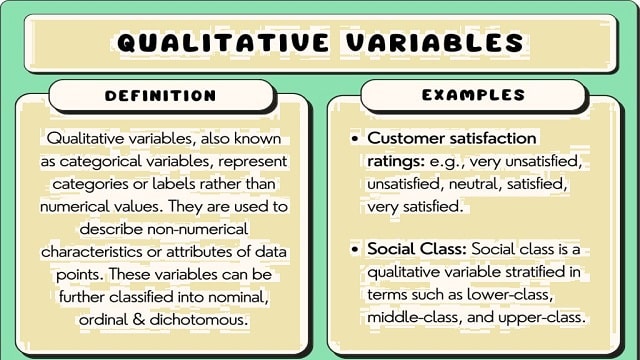What is a qualitative variable?
The qualitative variable is that statistical variable that expresses a quality, or characteristic, of the object or individual in question.
Some Important points
- The difference with quantitative ones is that qualitative ones are described with words and quantitative ones with numbers.
- The types that exist are: Dichotomous (two values) and polytomous (more than two values), subdivided into nominal (without order) and ordinal (with order).
- A qualitative variable describes non-numerical qualities or characteristics.
Types of qualitative variables
The types are as follows:
- Dichotomous or binary: Only two possibilities are allowed. For example, national or foreign.
- Polytomous: They can have more than two values. These can, in turn, be subclassified into:
- Nominal: They cannot be ordered in a specific hierarchy, for example, profession.
- Ordinals: These are those that can be ordered, for example, the level you have in a language: basic, intermediate, advanced, or native.
Qualitative variable: Simple explanation
In other words, it is a way of describing non-numerical characteristics of people, objects or situations. It is used to classify and analyse qualities that cannot be measured with numbers. For example, marital status, educational level, or nationality.
These variables help us better understand the qualitative aspects of a study group and are essential in research where it is necessary to categorize or describe characteristics rather than measure them.
Difference Between Qualitative And Quantitative Variables
The main difference between a qualitative and quantitative variable is that the former represents a characteristic of the subject or object in question that can be explained in words, while a quantitative variable is basically expressed in numbers.
In this sense, we can remember, as we mentioned above, that a qualitative variable can be associated with a number for statistical purposes. We can assign, for example, the numbers 1, 2, and 3, respectively, to the school, university, and postgraduate level. But this does not imply that the level of education attained ceases to be a qualitative variable.
A different case is that of quantitative variables, which are figures. A clear example of this is a person’s salary or age.
It should also be noted that quantitative variables are exact, unlike qualitative variables, which tend to be more relative.
For example, the weight of a gym dumbbell maybe 20 kg. This is an exact value. However, a qualitative one could be the condition of that dumbbell, which cannot always be determined precisely. Some people may find it in relatively good condition, while others may think that the tool requires maintenance.
Example of a qualitative variable
Here are some examples:
- We can classify a sample of people according to their marital status. In this sense, we speak of single, married, widowed, or divorced.
- Passengers on an international flight may be in economy or business class, these two possible categories being dichotomous qualitative variables.
- Students in a class can be divided into three groups by drawing lots, each corresponding to a color, for example, yellow, red, and blue. This color is a qualitative variable.
- The inhabitants of a city can be divided according to their district or specific area of residence, which would also be a qualitative variable.
- A group of citizens can be classified according to the socioeconomic stratum: A, B, C, D, or E. This depends on the range within which their income level falls. In this case, for example, Maria Perez perhaps earns X amount of euros, which would be a quantitative variable and belongs to socioeconomic level C, which would be a qualitative variable.

